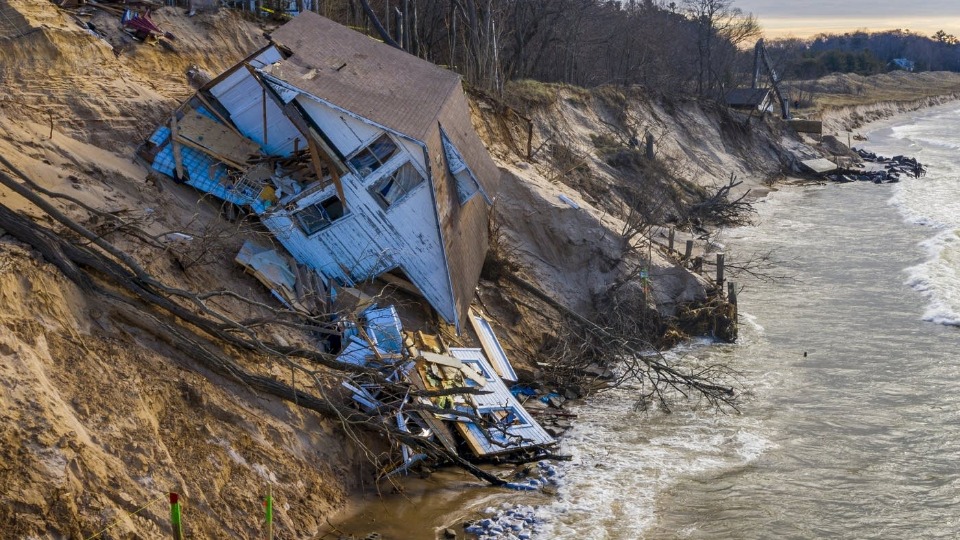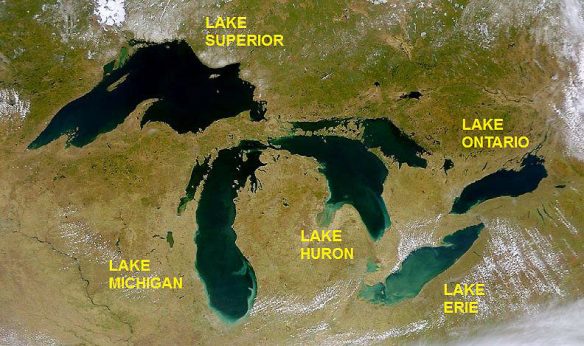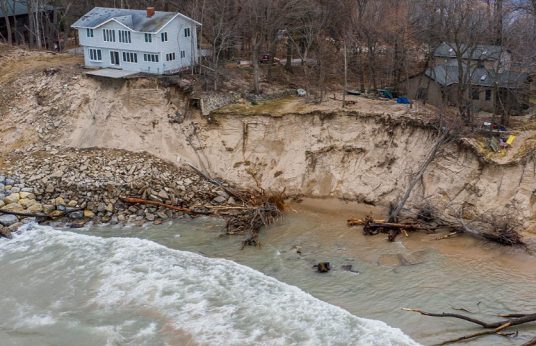
CHICAGO—It’s not just the Florida coast or tiny far-flung Pacific islands being swallowed up by the rising waters of climate change anymore. Now, record high water levels, severe storms, and stronger-than-normal wave activity are bringing the problem inland—right into the heartland of North America.
Rapid erosion and flooding are plaguing communities all along the Great Lakes and St. Lawrence River, and over just the next five years, surrounding towns and cities are expected to need almost $2 billion to combat the coastal damage wrought by climate change. The hefty bill has mayors begging Congress to include targeted funds in the infrastructure bill.

According to survey data just released by the Great Lakes and St. Lawrence Cities Initiative, most city and community leaders in the impacted jurisdictions say funding for rescuing their waterfront areas is a high priority but that current federal support is not meeting the need. The Cities Initiative is a binational coalition of over 120 mayors and local officials in the U.S. and Canada working together to protect and restore the Great Lakes and St. Lawrence River basin.
Mayor Walter Sendzik, who chairs the coalition, says that “while water levels in the Great Lakes-St. Lawrence basin are naturally variable with cyclical highs and lows,” the flooding and erosion caused by climate change in recent years “are exacerbating these fluctuations.”
The survey—conducted with the University of Illinois Applied Research Institute and covering over 240 cities, towns, and villages—found that in just the past two years, the affected communities have already spent more than $878 million dollars to fight erosion. Collectively, they foresee at least another $1.94 billion will have to be sunk in over the next half-decade.
The Cities Initiative believes the figures are probably only a fraction of what is actually required because many more jurisdictions along the troubled waters are not included in the tallies.
Together, the eight U.S. states bordering the Great Lakes—Minnesota, Wisconsin, Michigan, Illinois, Indiana, Ohio, Pennsylvania, and New York—have nearly 5,000 miles of shoreline. That’s almost as much as every single state bordering the Atlantic, Pacific, and Gulf of Mexico combined. The two Canadian Great Lakes provinces—Ontario and Quebec—boast another 5,300 miles of shoreline.
More than 80% of North America’s surface freshwater supply is found within the lakes, with over 40 million people relying on them for drinking water. And together with the St. Lawrence Seaway, the lakes are the central hub for an economy estimated to produce $6 trillion USD in GDP annually. The region is particularly important as a manufacturing center because of land-sea logistics integration and the cheap electricity provided by hydropower.
But the fast advance of climate change coastal damage threatens to gobble up an increasing amount of financial resources. Sendzik says “public and private properties, critical infrastructure, and recreation and tourism amenities” are all in the crosshairs. And most of the cities and towns included in the survey data say they aren’t equipped to handle the problem on their own. Only 11% of responding municipalities reported having a high level of local staff capacity to respond to climate change problems. Across the board, mayors say they need more support from state and federal agencies if they are going to protect their coasts from being washed away.
Most towns say they are struggling to keep up. Based on the data, the Cities Initiative believes that most communities are “severely behind in their efforts to develop climate action plans.” Only 30% reported having started or completed any progress on putting together an approach to fight climate change.
Essentially, the challenge comes down to money and coordination. The Cities Initiative is telling federal lawmakers point-blank that they need help. Mayor Tom Barrett of Milwaukee said that Great Lakes communities “face a growing crisis.” Coastal infrastructure is vital to the economic and recreational health of cities like his, and he says that they need “both the federal governments of the U.S. and Canada to assist with the necessary investments.” The piecemeal approach of leaving it up to local municipalities doesn’t measure up to the scale of the problem, which crosses state and national borders

In a joint letter to key Senate and House committee chairs last month, the Cities Initiative—along with several coalition partners—requested targeted funding for drinking water, wastewater, and stormwater infrastructure. The coalition of groups also urged Congress to include funds for coastal resilience and pitched the economic benefits of such infrastructure work—estimating that every $1 million spent could create 39 jobs.
Securing the funds needed remains a challenge, however. President Joe Biden’s “hard” infrastructure bill—the American Jobs Plan—originally proposed $2 trillion over eight years, with battling climate change listed as one of its priorities. Intransigence from Senate Republicans, the threat of a filibuster, and wavering Democratic centrists have conspired to whittle the bill down to $579 billion, though—just over a quarter of its original size.
The latest version of the bill under negotiation does include funds for ports and “water infrastructure,” but the final totals and actual projects remain undetermined. Any legislation having to do with climate change or the environment in Congress always garners overzealous scrutiny, and often sabotage, from lawmakers connected to extractive industries and their climate skeptic front groups.
The members of the Cities Initiative are watching what happens in Congress, but they aren’t just waiting around for Washington. They’ve already set the agenda for their convention later this year: “Preparing our Communities for the Future: Climate Change 2021 and Beyond.” Their cooperation will carry on, but their efforts would certainly get a boost if the American Jobs Plan were passed.












Comments